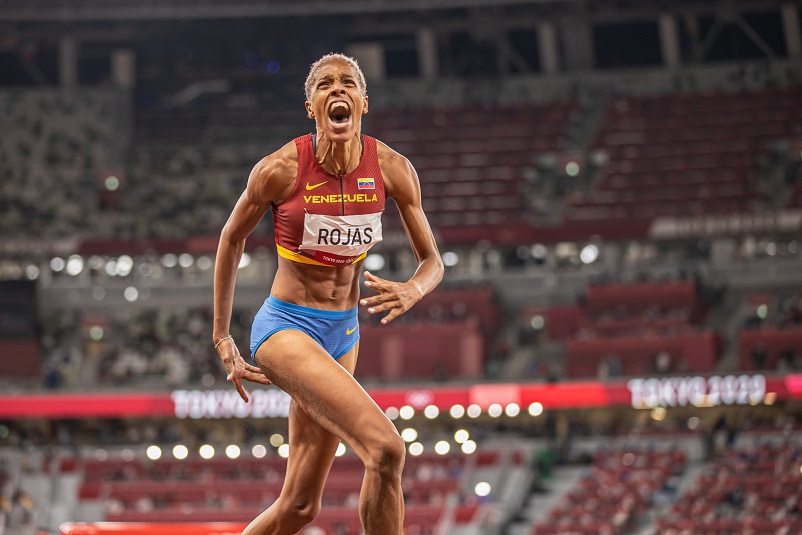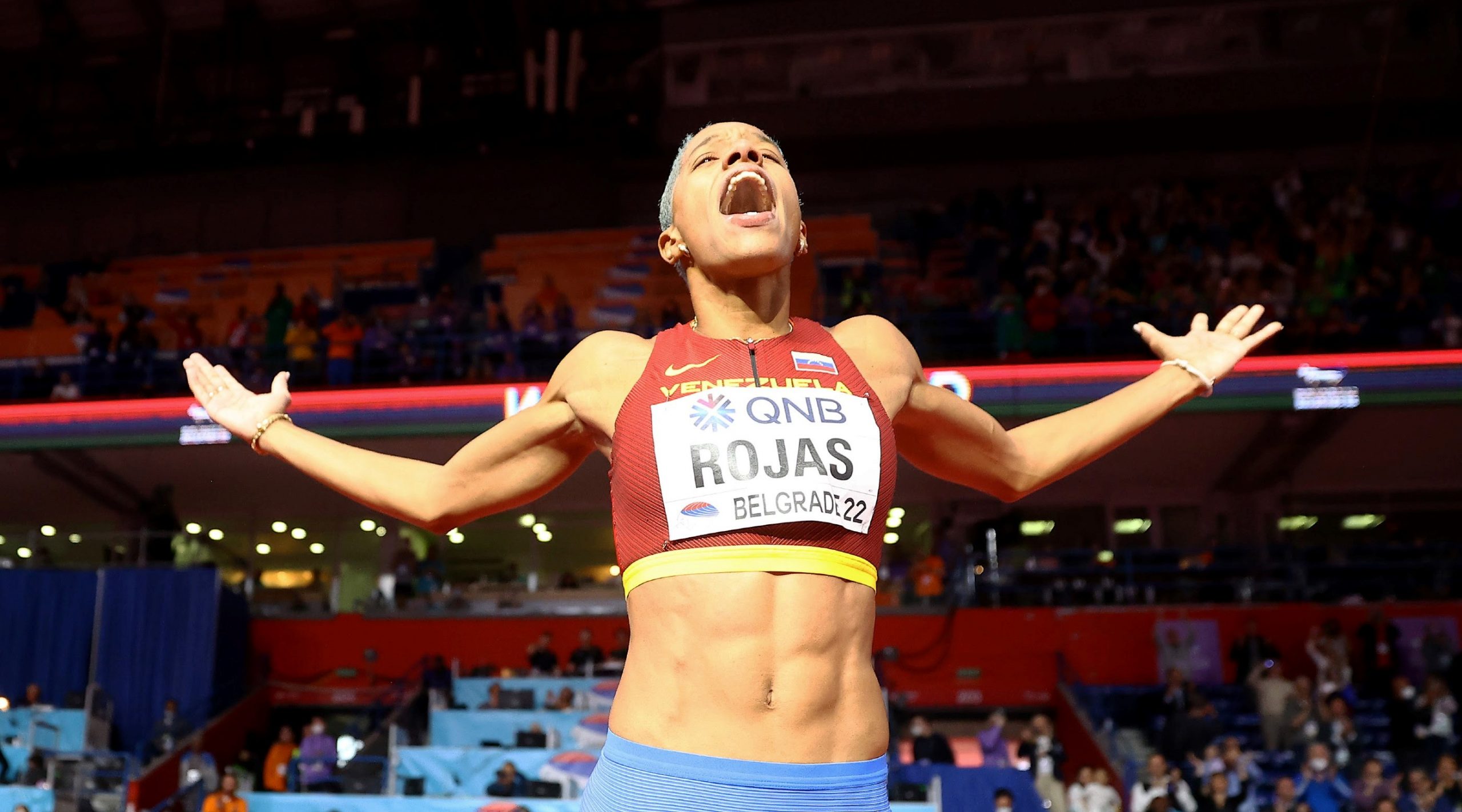 Every so often in sport, an athlete comes along with a level of talent so otherworldly, and a biological composition so perfectly suited to an event, that it seems, as the old cliche goes, they were simply born to do it.
Every so often in sport, an athlete comes along with a level of talent so otherworldly, and a biological composition so perfectly suited to an event, that it seems, as the old cliche goes, they were simply born to do it.
Yulimar Rojas is that kind of athlete. When she takes to the triple jump runway the Venezuelan, who stands at 1.92m, holds thousands of fans captive in her grasp – her speed, power and astonishing elasticity offering up the promise of something ridiculous, something absurd, as she bounces off the board and bounds towards the sand.
On the final day of the World Athletics Indoor Championships Belgrade 22, that’s exactly what occurred, Rojas setting an outright world record with her 15.74m* in the sixth round.
Her closest rival was a full metre behind.
That sense of timing, showmanship and electrifying entertainment has become Rojas’s trademark. She did the same in Tokyo, saving her best for the final round, where she smashed the world record with 15.67m.
So, what is it about saving her best for last?
“I’ll tell you the truth, I don’t know,” she says. “It didn’t feel any different, but it is the jump for glory. Maybe one day I’ll be known as ‘the girl of the sixth jump’.”
She’s 26 now, and Rojas has already done it all, won it all. What’s left? One specific number.
“I was born to jump 16 metres,” she says. “This is what inspires me to inspire others to achieve their dreams, and help athletics remain the best sport in the world.”
PROFILE
Born: Caracas, 21 October 1995. Coach: Ivan Pedroso.
Yulimar Rojas was born in Caracas, but her athletic talent was nurtured in the eastern state of Anzoategui on the shores of the Caribbean Sea.
Volleyball was the first sport she practised, at the age of 14. A tall girl, she was attracted by the possibility to take advantage of her height and the success of the Venezuelan women’s team, which had qualified for the 2008 Olympic Games a couple of years prior.
A lack of volleyball coaches prevented her from taking up that sport. Instead, athletics coaches took note of her potential.
Rojas and her family lived in a ‘ranchito’, a shanty house made of bricks and a zinc roof, commonly found in poor neighbourhoods around the country. But poverty wasn’t the only obstacle during her early years in the sport. Despite being selected for the national team in the high jump, Rojas’s father refused to give his consent to allow Rojas to travel to international competitions.
Eventually she was allowed to compete overseas and she first enjoyed international success when winning the high jump at the 2011 South American U20 Championships in Medellin.
She made something of a breakthrough in 2013, setting two national U20 records on the same day in Barquisimeto, clearing 1.87m in the high jump and landing at 6.17m in the long jump. That year she also earned high jump silver at the Pan American U20 Championships in Cali and at the Bolivarian Games in Trujillo.
In 2014, she tried the triple jump for the first time and set a national U20 record of 13.57m on her debut. She persevered with the other jumping events, though, and won the high jump at the South American Games in Chile that year.
Her focus changed to the horizontal jumps and she competed in both the long and triple jumps at the World U20 Championships in Eugene, reaching the final of the former. Later in the year, she won both horizontal jumps at the South American U23 Championships in Montevideo.
In recognition of her athletic achievements, her family was given better housing and her younger sister Yerilda Zapata qualified for the 2014 Youth Olympic Games in Nanjing, where she competed in the discus.
She set her first senior national records at the 2015 Venezuelan Championships, leaping 6.57m in the long jump and 14.17m in the triple jump. After a long season of competitions, and with an aching body, she decided against competing at the World Championships. But watching the event on TV made her realise she had the potential to be among the world’s best.
After linking up with Ivan Pedroso in late 2015, Rojas moved to Spain for the next chapter in her athletics development. The move soon paid dividends with Rojas improving to 14.69m during the 2016 indoor season and winning the world indoor title in Portland. Outdoors, she sailed out to 15.02m and claimed Olympic silver in Rio with 14.98m.
That was to be Rojas’s last defeat at a global championships.
In 2017 she won her first outdoor world title, beating defending champion Caterine Ibarguen.
Ankle injuries ruled her out for almost the entire 2018 season, but she managed just one competition – the World Indoor Championships in Birmingham – and successfully defended her title.
Back to full fitness in 2019, Rojas started the year with an indoor PB of 14.92m and regularly landed beyond the 15-metre line outdoors, topped by a 15.41m South American record in Andujar in September.
One month later in Doha, she retained her world title with 15.37m, the second-best jump of her career.
Rojas didn’t have to wait long to make even more history. On 21 February 2020, she bounded out to a world indoor triple jump record of 15.43m in Madrid, adding seven centimetres to a mark which had stood since 2004.
She wasn’t done there, though, and Inessa Kravets’ world outdoor record of 15.50m looked on borrowed time. Opening her 2021 summer season with 15.14m in Ibiza, she went on to jump further than 15 metres in all her four other competitions in the lead up to the Olympic Games in Tokyo.
Once there, on the biggest stage of them all, she first broke the Olympic record with a leap of 15.41m from her opening attempt. Five rounds later she had the victory secured and gave the last leap her all, recording 15.67m to add 17 centimetres to Inessa Kravets’ world outdoor record that had been set at the 1995 World Championships. That saw Rojas secure Venezuela’s first ever Olympic title in athletics in style.
From there, she claimed another win at the Diamond League meeting in Lausanne, leaping 15.56m, and then secured the overall Diamond League title with a 15.48m jump in Zurich.
She picked up from where she left off in 2022. After opening her season with a couple of long jump competitions, she recorded 15.41m on her triple jump season debut to miss her own world indoor record by just 2cm.
She knew there was much more to come, though, and on the world stage in Belgrade, she proved it. After opening with a safe looking 15.19m in the first round, she then fouled in the second. In the third she was beyond 15 metres again, but such is her standard that after the attempt she stayed sitting in the sand, clearly frustrated to not have gone further.
She had another big jump in round four – landing in the sand at a mark that looked near her own world lead of 15.41m – but that was judged a foul. The next was not. Soaring through the air, she landed and leapt straight back up, watching the scoreboard in anticipation. First came the green light and then the distance – 15.36m to match the championship record set in 2004 and miss her own world indoor record by just 7cm.
She wasn’t done. Taking to the runway one last time, she engaged the crowd and was roared to her fifth consecutive global gold medal and another world record of 15.74m, winning by exactly a metre.
STATS
Rojas’s progression (high jump, long jump, triple jump)
2010: 1.63m, 5.42m, –
2011: 1.81m, 5.57m, –
2012: 1.75m, 5.93m, –
2013: 1.87m, 6.23m, –
2014: 1.82m, 6.48m, 13.65m
2015: 1.80m, 6.57m, 14.20m
2016: -, -, 15.02m
2017: -, -, 14.96m
2018: -, -, 14.63m
2019: -, 6.26m, 15.41m
2020: -, 6.59m, 15.43m
2021: -, 6.88m (7.27w), 15.67m
2022: -, 6.81m, 15.74m*
Outright world record progression
14.54m Li Huirong (CHN) Sapporo 1990
14.95m Inessa Kravets (URS) Moscow 1991
14.97m Yolanda Chen (RUS) Moscow 1993
15.09m Anna Biryukova (RUS) Stuttgart 1993
15.50m Inessa Kravets (UKR) Gothenburg 1995
15.67m Yulimar Rojas (VEN) Tokyo 2021
15.74m (i) Yulimar Rojas (VEN) Belgrade 2022*
World outdoor all-time list
World indoor all-time list
Under current rules, the indoor world triple jump record is now accepted as the overall world record if it is further than the best outdoor performance.
*Subject to the usual ratification procedure
- WORLD ATHLETICS
































